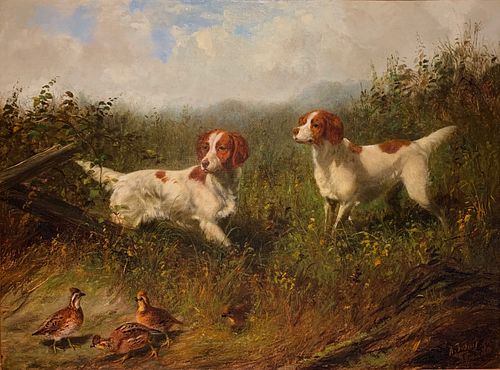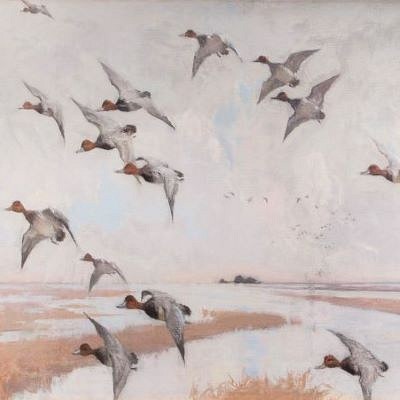Arthur Fitzwilliam Tait (1819-1905) Setters on Quail
About Seller
20 Winter Street
Pembroke, MA 02359
United States
Founded in 2005, Copley Fine Art Auctions is a boutique auction house specializing in antique decoys and American, sporting, and wildlife paintings. Over the course of the last two decades, the firm has set auction records for not only individual decoy makers, but also entire carving regions. Copley...Read more
Two ways to bid:
- Leave a max absentee bid and the platform will bid on your behalf up to your maximum bid during the live auction.
- Bid live during the auction and your bids will be submitted real-time to the auctioneer.
Bid Increments
| Price | Bid Increment |
|---|---|
| $0 | $50 |
| $1,000 | $100 |
| $2,500 | $250 |
| $5,000 | $500 |
| $10,000 | $1,000 |
| $25,000 | $2,500 |
| $50,000 | $5,000 |
About Auction
Feb 19, 2021
Lots 1-292 Copley Fine Art Auctions cinnie@copleyart.com
- Lot Description
Arthur Fitzwilliam Tait (1819-1905)
Setters on Quail, 1883
signed and dated "A.F. Tait. NA NY 83" lower right
oil on canvas, 12 by 16 in.
Also titled Two Setters and Quail, this painting is recorded in Tait's register as "2 Setters and Quail 12 x 16 Mr. Hy Hentz (Sen'r) for X'mas. to be $100.00 Frame extra."
Henry Hentz founded a brokerage firm in New York in 1856, and was a charter member and president of the New York Cotton Exchange. Hentz bought multiple paintings from Tait in 1883 and 1884, according to the artist's registers. When Hentz died in 1924, both the cotton and coffee exchanges closed in his memory for the day.
Known as one of America's earliest sporting artists, Arthur Fitzgerald Tait was born in Liverpool, England, in 1819. From an early age, he was interested in both art and the outdoors. Tait worked for the firm of Thomas Agnew, a famous art dealer and lithographer in Manchester, trained in lithography and drawing, and explored the open land around the city. However, many of the most beautiful vistas and hunting grounds were private and off limits. While in the employ of the art firm, Tait was exposed to the works of Edwin Landseer (1802-1873), Richard Ansdell (1818-1885), and John Frederick Herring (1815-1907), among others.
In Liverpool, beginning in 1843, Tait spent time with fellow artist George Catlin (1796-1872), which may have whetted the young artist's appetite to explore life in America. Catlin, who was twenty-three years older than Tait, had spent much of the previous decade living in the American West chronicling the life of American natives through his careful drawings and sketches of their clothing, weapons, and ceremonies. There is little doubt that Catlin's stories would have captivated the young and talented Tait.
In 1850 Tait boarded a boat with his wife and came to America. By 1852 Tait was pursuing his interests in wildlife and hunting, based on the subject matter of his works. He worked from a studio in New York City, but spent a great deal of time on Long Lake in the Adirondacks, where he acquired skills as an angler, hunter, and keen observer of wildlife. These skills were as important for Tait's art as his fine ability with brush and pigment, since they gave an authenticity to his portrayals of outdoor life which was virtually unrivalled at the time. His relative freedom to paint wherever he wanted in the vast public lands of New York was obviously liberating to the artist, who had felt confined by the strict laws governing trespassing and hunting on private property in England.
With this liberation and experience of the outdoors, Tait's artistic career flourished. In 1852, only two years after Tait arrived in New York, Nathaniel Currier (1813-1888) and James Merritt Ives (1824-1895) purchased the first of many works from the budding artist. In that same year, Tait was asked to hang a half-dozen works at the National Academy of Design's annual exhibition. By 1854 he had achieved an associate membership and four years later he became a full member. Editions of Tait's works for Currier and Ives were reproduced by the thousands and formed some of America's most iconic images of the Victorian era. The exceptionally popular "American Field Sports" series showcased Tait's abilities as an upland bird and dog painter and included the four lithographs "A Chance for Both Barrels," "Flushed," "On a Point," and "Retrieving." These hunting scenes, along with his camping and woodland scenes, resonated with the public as an integral part of the American experience and continue to inform us of our history as a nation. Seminal works by Tait, such as "An Anxious Moment," "A Tight Fix," and "Trappers at Fault: Looking for the Trail," have become embedded as part of our heritage and serve as signposts along our path as a nation.
Today Tait's wilderness, frontier, and wildlife scenes hang in some of the most prominent museums and private collections, including the permanent collections of the Addison Gallery of American Art, Andover, Massachusetts; the Adirondack Museum, Blue Mountain Lake, New York; the American Museum of Western Art, Denver, Colorado; the Amon Carter Museum, Fort Worth, Texas; the Brooklyn Museum, New York; the Corcoran Gallery of Art, Washington, DC; the Denver Art Museum, Colorado; the Metropolitan Museum of Art, New York; the National Museum of Racing, Saratoga Springs, New York; the Shelburne Museum, Vermont; the Yale University Art Gallery, New Haven, Connecticut; the Tate Gallery, London; and the Victoria & Albert Museum, London, among others.
Setters on Quail is one of the artist's greatest renderings of bird dogs on bobwhite quail hailing from one of the finest sporting art collections ever assembled.
Provenance: Henry Hentz Collection, New York
Private Collection, Florida 1999 to present
Literature: Warder H. Cadbury and Henry F. Marsh, Arthur Fitzwilliam Tait: Artist in the Adirondacks, Newark, DE, 1986, p. 268, no. 83.41.Please email condition report requests to leah@copleyart.com. Any condition statement given is a courtesy to customers, Copley will not be held responsible for any errors or omissions. The absence of a condition statement does not imply that the lot is in perfect condition.Condition
- Shipping Info
-
Copley Fine Art Auctions does not handle the shipping of any items. Shipping is the sole responsibility of the buyer. Once your payment has cleared and we have received your shipping form, items may be released for shipment. Copley Fine Art Auctions, LLC shall have no liability for any loss or damage to such items. Buyers should allow up to four weeks for shipment.
Please be aware that internet bidders may NOT not pick up their items at the sale. Items will be available for pick up by appointment or by shippers five days after the sale.
-
- Buyer's Premium



 EUR
EUR CAD
CAD AUD
AUD GBP
GBP MXN
MXN HKD
HKD CNY
CNY MYR
MYR SEK
SEK SGD
SGD CHF
CHF THB
THB














